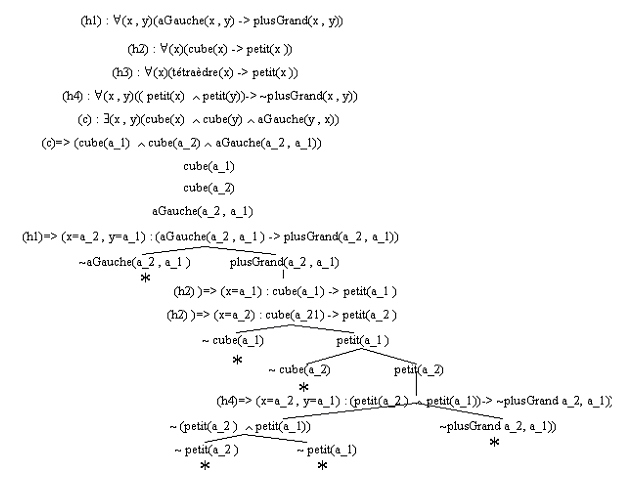
/* une diée de ce qui était attendu
...
1- Preuves :

2- Prolog :
listeBONUS(LISTEBONUS) :-
listeEtudiants(L), % pour passer de l'ensemble des faits étudiant/3 à la liste L des termes étudiant/3 cf. exemple de l'énoncé
listeEtudiantsRendusSup2MAX(L ,L1), % pour passer de la liste des termes étudiant/3 L à la liste L1 des termes étudiant/5
listeB(L1 , LISTEBONUS). % on balaye la liste L1 des termes étudiant/5 pour construire la liste des termes bonus/3 demandée
listeB([] , []).
listeB([étudiant(N , M , _ , _ , Sup2 , MAX) | L] , [bonus(N , M , 3) | LB] ) :- compare(> , Sup2, 8) , compare(> , MAX, 3) ,!, listeB(L ,LB) .
listeB([étudiant(N , M , _ , _ , SUP2 , _) | L] , [bonus(N , M , 2) | LB] ) :- compare(> , SUP2 , 7) , !, listeB(L ,LB) .
listeB([étudiant(N , M , _ , Rendus , _ , _) | L] , [bonus(N , M , 1) | LB] ) :- compare(> , Rendus , 9) , !, listeB(L ,LB) .
listeB([étudiant(N , M , _ , _ , _ , _) | L] , [bonus(N , M , 0) | LB] ) :- listeB(L ,LB) .
3-Logique de HOARE :
Q1 : de Java+ESC/JAVA à HOARE
{ n >= 1}
m := MAX_VALUE;
{ 'A' k; k>=0 & k<n -> a[k]<m)}
mindex := 0; i:=0;
{ 'A' k; k>=0 & k<n -> a[k]<m) & i=0 & mindex = 0}
while(i<n)
invariant ('A' k : k>=0 & k<i -> m<=a[k]) & 0 <= mindex & mindex <= i & i>=0 & i<=n
variant n-i;
do if (a[i] < m) then mindex = i;m = a[i] end ; i := i+1 end
{'A' k; k>=0 & k<n -> m<=a[k] & 0 <= mindex & mindex <= n);
Q2 : 5 obligations de preuves selon les 5 points du canevas
(i)( 'A' k : k>=0 & k<n -> a[k]<m) & i=0 & mindex = 0) -> (('A' k : k>=0 & k<i -> m<=a[k]) & 0 <= mindex & mindex <= i & i>=0 & i<=n)
(ii)invariant de la boucle(en remontant)
(('A' k : k>=0 & k<i -> m<=a[k]) & 0 <= mindex & mindex <= i & i>=0 & i<=n & i<n)
while(i<n) do if (a[i] < m) then mindex = i;m = a[i] end ; i := i+1 end
('A' k : k>=0 & k<i -> m<=a[k]) & 0 <= mindex & mindex <= i & i>=0 & i<=n
(iii)post condition
(('A' k : k>=0 & k< i -> m<=a[k]) & 0 <= mindex & mindex <= i & i>=0 & i<=n & i>=n )
-> (('A' k : k>=0 & k<n -> m<=a[k] )& 0 <= mindex & mindex <= n))
(iv)ARRET de la boucle :
(('A' k : k>=0 & k<i -> m<=a[k]) & 0 <= mindex & mindex <= i & i>=0 & i<=n & i<n) -> (n-i>0)
(v) V:= n-i; if (a[i] < m) then mindex = i;m = a[i] end; i := i+1 {n-i<V}
Q3 : preuve du point (v)
V:= n-i;
if (a[i] < m) then mindex = i;m = a[i] end;
i := i+1
{n-i<V} // en remontant
remarque : if (a[i] < m) then mindex = i;m = a[i] end; ne modifie pas les valeurs de i et n donc on peut ne pas tenir compte de cette instruction dans la preuve, d'où
{n-i-1<n-i} toujours vraie...
V:= n-i;
{n-i-1<V}
i := i+1
{n-i<V} // en remontant
class CommandeAllumerSpot implements Command {
private Spot monSpot;
public CommandeAllumerSpot ( Spot L) {monSpot = L;}
public void execute( ) {monSpot . turnOn( );}
}
class CommandeEteindreSpot implements Command {
private Spot monSpot;
public CommandeEteindreSpot ( Spot L) {monSpot = L;}
public void execute( ) {monSpot . turnOff( );}}
class CommandeMarcheVentilo implements Command {cf CommandeAllumerSpot }
class CommandeStopVentilo implements Command {cf CommandeEteindreSpot }
public class TestCommand {
public static void main(String[] args) {
Spot testSpot = new Spot( );
CommandeAllumerSpot testLOC = new CommandeAllumerSpot(testSpot);
CommandeEteindreSpot testLFC = new CommandeEteindreSpot(testSpot);
Interrupteur testInter = new testInter ( testLOC,testLFC);
testInter.flipUp( ); testInter.flipDown( );
Ventilo testVentilo = new Ventilo( );
CommandeMarcheVentilo foc = new CommandeMarcheVentilo(testVentilo);
CommandeStopVentilo ffc = new CommandeStopVentilo(testVentilo);
Interrupteur ts = new Interrupteur( foc,ffc);ts.flipUp( ); ts.flipDown( );
}}